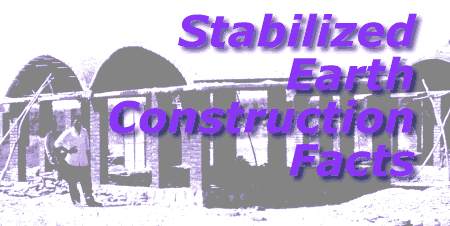|
Earthwalls improve the
quality of the indoor environment.
Unlike wood-frame buildings, packed full of potentially harmful manufactured
materials which can outgas hazardous fumes for months, an earth walled
building with a natural finish emits no toxins whatsoever.
|
The ability of a solid
earth wall to store energy for long periods of time results in interior
temperatures that change very little from day to night. Mass walls absorb
solar energy during winter days and theradiate that energy to offset nighttime
heat losses within the building.
In the summer months, the mass of the walls absorbs
excess heat generated during the day, keeping the inside spaces surprisingly
cool, then releases that stored heat to the clear night sky.
And because the energy that controls the temperature
inside the building radiates directly from
the mass of the walls, the quality of the comfort inside is noticeably
different than in a space regulated through mechanically altered air.
|
|
Walls built of raw
earth in China, Africa, India and even the cold wet climates of northern
Europe continue to provide shelter after several hundred years of use.
With the addition of concrete foundations, we can say in total confidence
that our earth walls can last for centuries.
And like all other masonry wall systems, whether
they are brick, stone, or concrete, exterior maintenance is virtually
eliminated.
|
Two important reasons for choosing to build
with solid earth walls are that they are fireproof and resistant to damage
from termites and other insects.
Both these factors contribute to greater longevity,
of course, but they can also mean an important increase in safety for
you and for future owners.
|
|
So, "What happens when it rains?" The answer
is that if the soil is selected properly and the wall constructed according
to specifications, the finished product is as at least as resistant to
deterioration as the parent rock from which the soil came, and some cases
even more so.
Tests conducted on samples of finished walls demonstrate that stabilized
earth can be completely saturated for months at a time without any deterioration
whatsoever.
However not all soils are ideal, and because earth loses its insulative
properties when it becomes wet, in climates where rainfall can be extreme
like India, walls should be protected against saturation with ample roof
overhangs and raised foundations.
|
Perhaps the best reason to build with earth
is the boost it can give to the health of the planet. Earth is an unprocessed,
widely available building material with virtually no side effects associated
with its harvesting or use. Since an earth walled building saves construction
and energy resources, doesn't pollute, and lasts practically forever it
a wise investment in the future of the planet.
|



